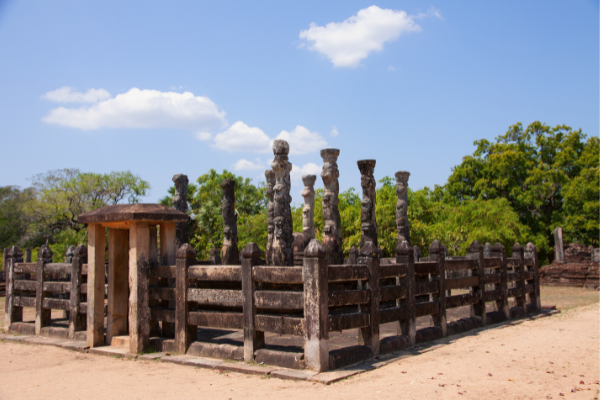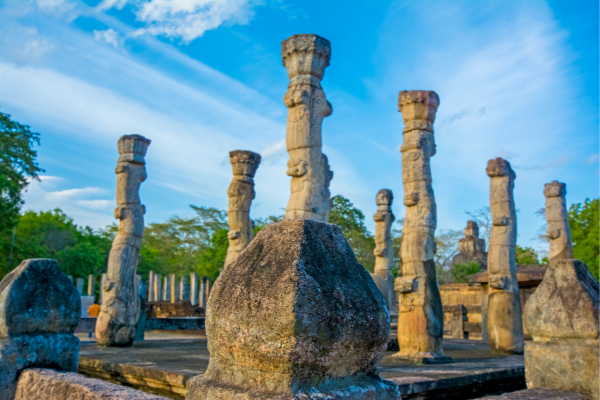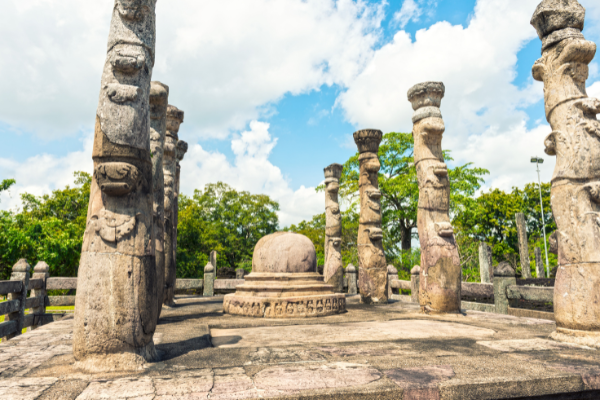Nissanka Latha Manadapaya – a unique structure of yesteryear – By Arundathie Abeysinghe

 Constructed during the reign of King Nissanka Malla (1187-1196) and named after him as Nissanka Latha Manadapaya *(Mandapaya meaning pavilion), this extraordinary unique structure is located near the western entrance of the *Dalada Maluwa quadrangle of Polonnaruwa District in North Central Province, Sri Lanka. *Polonnaruwa region comprises the oldest and most sacred Buddhist and historical monuments. Hence, the monument is considered as significant as it showcases how Buddhism influenced society during the *Polonnaruwa Kingdom. Some archaeologists are of the view that the Complex is also known as the ‘King’s Court.’
Constructed during the reign of King Nissanka Malla (1187-1196) and named after him as Nissanka Latha Manadapaya *(Mandapaya meaning pavilion), this extraordinary unique structure is located near the western entrance of the *Dalada Maluwa quadrangle of Polonnaruwa District in North Central Province, Sri Lanka. *Polonnaruwa region comprises the oldest and most sacred Buddhist and historical monuments. Hence, the monument is considered as significant as it showcases how Buddhism influenced society during the *Polonnaruwa Kingdom. Some archaeologists are of the view that the Complex is also known as the ‘King’s Court.’
The structure is an elevated stone platform with several stone columns carved exquisitely and this type of columns are not found anywhere else in the country. These stone columns are not straight unlike most stone columns in many historic sites in Sri Lanka. These columns are curved in three places. Unique features of Nissanka Latha Manadapaya are these stone columns that are surrounded by a low stone wall. The eight granite columns are arranged in two rows with four in each row which scholars are of the view that they would have supported a roof, each of them is approximately 8 feet 4 inches (2.54 meters) in height. The crown is carved in the shape of a blossoming lotus bud in each of these columns, whereas the rest of the column is intricately carved to resemble the stem of the flower.
Nissanka Latha Manadapaya is a square-shaped structure with outstanding rock cut railing and has an open-air design. The structure is surrounded by a stone railing and a low stone fence of horizontal granite posts with the entrance protected by a stone doorway.
According to the renowned archaeologist, *Professor Senarath Paranavithana. the stone columns in Nissanka Latha Manadapaya are the best examples of the ancient architectural styles in Sri Lanka.

There is a small stupa (dagoba) made from stone at the center of the platform flanked by the stone columns. Yet, the top part of it has been destroyed due to enemy invasions. The base is decorated with a carved design and the platform is surrounded by a stone railing. There is a single stone doorway to enter the structure. Although, there are exquisitely carved stone pillars, these have a non-decorated and simple finish.
According to a stone inscription located nearby this is the building utilized by King Nissanka Malla to listen to *pirith.
According to scholars, Nissanka Latha Mandapaya is considered as King Nissanka Malla’s magnum opus as it is one of the most extraordinary imposing historical places, in terms of artwork in Sri Lanka.
The best period to visit this site are from May to September as these months are drier. The best time is early morning or late evening as the heat is less and the number of tourists visiting the stie are also minimal.
- Chola conquest – This was a military invasion of the Anuradhapura Kingdom by the Chola Empire of Southern India, one of the longest ruling dynasties in world history. Initially, the Anuradhapura Kingdom was invaded in 993 AD and absorbed it into the Chola Empire of Southern India.
- Dalada Maluwa – The site in which the Sacred Tooth Relic was housed.
- King Parakramabahu I (1153-1186) – King Parakramabahu I oversaw the expansion and beautification of the Polonnaruwa Kingdom and constructed extensive irrigation systems, reformed Buddhist practices, encouraged the arts, reorganized the country’s army and undertook military campaigns in South India and Burma.
- Mandapaya – Also known as “Maduwa”, Mandapaya is a pillared structure open on all sides and protects the people inside from the sun with a roof.
- Pirith – Pirith is the Sinhala word for paritta (Pali) which means protection, the recitation or chanting of the word of the Buddha, the chanting of Buddhist scriptures.
- Polonnaruwa – Also referred as “Pulathisipura” and “Vijayarajapura” in ancient times, Polonnaruwa is the main town of Polonnaruwa District in North Central Province. The modern town of Polonnaruwa is also known as “New Town” and the other part of Polonnaruwa remains as the royal ancient city of the Kingdom of Polonnaruwa. Polonnaruwa was the second capital of Sri Lanka after the destruction of Anuradhapura Kingdom in 993. The town comprises, the Brahmanic monuments constructed by the *Cholas as well as the monumental ruins of the fabulous garden-city created by *King Parakramabahu I (1153-1186) in the 12th century.
- Professor Senarath Paranavithana (1896 – 1972) – Pioneering archeologist and renowned epigraphist of Sri Lanka, his works dominated Sri Lankan archaeology as well as history during the middle-part of the 20th century. In 1940, he assumed duties as the Commissioner of Archeology.

Royal Palace Polonnaruwa – architectural marvel of yesteryear – By Arundathie Abeysinghe – Dec 17, 2022







